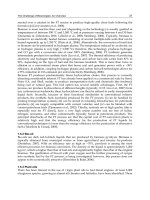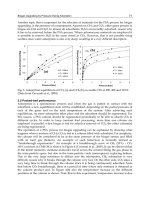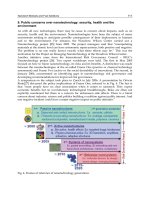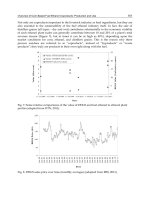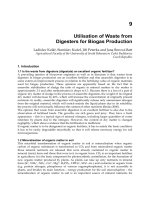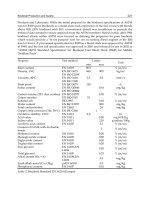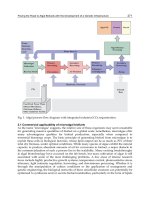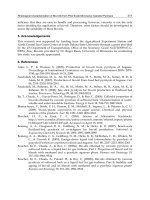Biofuel''''s Engineering Process Technology Part 1 doc
Bạn đang xem bản rút gọn của tài liệu. Xem và tải ngay bản đầy đủ của tài liệu tại đây (1.57 MB, 40 trang )
Biofuel's Engineering Process Technology
Edited by Marco Aurélio Dos Santos Bernardes
Published by InTech
Janeza Trdine 9, 51000 Rijeka, Croatia
Copyright © 2011 InTech
All chapters are Open Access articles distributed under the Creative Commons
Non Commercial Share Alike Attribution 3.0 license, which permits to copy,
distribute, transmit, and adapt the work in any medium, so long as the original
work is properly cited. After this work has been published by InTech, authors
have the right to republish it, in whole or part, in any publication of which they
are the author, and to make other personal use of the work. Any republication,
referencing or personal use of the work must explicitly identify the original source.
Statements and opinions expressed in the chapters are these of the individual contributors
and not necessarily those of the editors or publisher. No responsibility is accepted
for the accuracy of information contained in the published articles. The publisher
assumes no responsibility for any damage or injury to persons or property arising out
of the use of any materials, instructions, methods or ideas contained in the book.
Publishing Process Manager Petra Zobic
Technical Editor Teodora Smiljanic
Cover Designer Jan Hyrat
Image Copyright EMJAY SMITH, 2010. Used under license from Shutterstock.com
First published July, 2011
Printed in Croatia
A free online edition of this book is available at www.intechopen.com
Additional hard copies can be obtained from
Biofuel's Engineering Process Technology, Edited by Marco Aurélio Dos Santos Bernardes
p. cm.
ISBN 978-953-307-480-1
free online editions of InTech
Books and Journals can be found at
www.intechopen.com
Contents
Preface IX
Part 1 Process Control and Dynamics 1
Chapter 1 The Effect of Thermal
Pretreatment Process on Bio-Fuel Conversion 3
Aleksander Ryzhkov, Vadim Silin,
Tatyana Bogatova, Aleksander Popov and Galina Usova
Chapter 2 The Challenge of Bioenergies: An Overview 23
Nicolas Carels
Chapter 3 Biogas Upgrading by Pressure Swing Adsorption 65
Carlos A. Grande
Chapter 4 Use of Rapeseed Straight Vegetable
Oil as Fuel Produced in Small-Scale Exploitations 85
Grau Baquero, Bernat Esteban,
Jordi-Roger Riba, Rita Puig and Antoni Rius
Chapter 5 Nanotech Biofuels and Fuel Additives 103
Sergio C. Trindade
Chapter 6 Bioresources for Third-Generation Biofuels 115
Rafael Picazo-Espinosa, Jesús González-López
and Maximino Manzanera
Chapter 7 Overview of Corn-Based Fuel
Ethanol Coproducts: Production and Use 141
Kurt A. Rosentrater
Chapter 8 Biorefinery Processes for
Biomass Conversion to Liquid Fuel 167
Shuangning Xiu, Bo Zhang
and Abolghasem Shahbazi
VI Contents
Chapter 9 Utilisation of Waste
from Digesters for Biogas Production 191
Ladislav Kolář, Stanislav Kužel, Jiří Peterka and Jana Borová-Batt
Chapter 10 Biodiesel Production and Quality 221
Roseli Ap. Ferrari, Anna Leticia M. Turtelli Pighinelli and Kil Jin Park
Part 2 Process Modeling and Simulation 241
Chapter 11 Perspectives of Biobutanol Production and Use 243
Petra Patakova, Daniel Maxa, Mojmir Rychtera, Michaela Linhova,
Petr Fribert, Zlata Muzikova, Jakub Lipovsky, Leona Paulova,
Milan Pospisil, Gustav Sebor and Karel Melzoch
Chapter 12 Paving the Road to Algal Biofuels
with the Development of a Genetic Infrastructure 267
Julian N. Rosenberg, Michael J. Betenbaugh and George A. Oyler
Chapter 13 Rheological Characterization of Bio-Oils
from Pilot Scale Microwave Assisted Pyrolysis 293
Chinnadurai Karunanithy and Kasiviswanathan Muthukumarappan
Chapter 14 Co-production of Bioethanol and Power 317
Atsushi Tsutsumi and Yasuki Kansha
Chapter 15 Conversion of Non-Homogeneous Biomass to Ultraclean
Syngas and Catalytic Conversion to Ethanol 333
Stéphane C. Marie-Rose,
Alexis Lemieux Perinet and Jean-Michel Lavoie
Chapter 16 Novel Methods in Biodiesel Production 353
Didem Özçimen and Sevil Yücel
Chapter 17 Pyrolysis Oil Stabilisation by Catalytic Hydrotreatment 385
Venderbosch R.H.
and Heeres H.J.
Chapter 18 Biomass Feedstock
Pre-Processing – Part 1: Pre-Treatment 411
Lope Tabil, Phani Adapa and Mahdi Kashaninejad
Chapter 19 Biomass Feedstock
Pre-Processing – Part 2: Densification 439
Lope Tabil, Phani Adapa and Mahdi Kashaninejad
Part 3 Process Optimization 465
Chapter 20 Performances of Enzymatic Glucose/O
2
Biofuel Cells 467
Habrioux Aurélien, Servat Karine, Tingry Sophie and Kokoh Boniface
Contents VII
Chapter 21 Quantifying Bio-Engineering:
The Importance of Biophysics in Biofuel Research 493
Patanjali Varanasi, Lan Sun, Bernhard Knierim, Elena Bosneaga,
Purbasha Sarkar, Seema Singh and Manfred Auer
Part 4 Process Synthesis and Design 521
Chapter 22 Kinetic Study on Palm Oil Waste Decomposition 523
Zakir Khan, Suzana Yusup, Murni M. Ahmad,
Yoshimitsu Uemura, Vuoi S. Chok, Umer Rashid and Abrar Inayat
Chapter 23 Biofuels and Energy
Self-Sufficiency: Colombian Experience 537
Elkin Alonso Cortés-Marín and Héctor José Ciro-Velázquez
Chapter 24 Enzyme-Based Microfluidic
Biofuel Cell to Generate Micropower 565
A.Zebda, C. Innocent, L. Renaud, M. Cretin,
F. Pichot, R. Ferrigno and S. Tingry
Chapter 25 Energy Paths due to Blue Tower Process 585
Kiyoshi Dowaki
Chapter 26 Advances in the Development of Bioethanol: A Review 611
Giovanni Di Nicola, Eleonora Santecchia,
Giulio Santori and Fabio Polonara
Chapter 27 Effect of Fried Dishes Assortment
on Chosen Properties of Used Plant Oils as
Raw Materials for Production of Diesel Fuel Substitute 639
Marek Szmigielski, Barbara Maniak,
Wiesław Piekarski and Grzegorz Zając
Chapter 28 Recent Development
of Miniatured Enzymatic Biofuel Cells 657
Yin Song, Varun Penmasta and Chunlei Wang
Chapter 29 Biorefining Lignocellulosic Biomass
via the Feedstock Impregnation
Rapid and Sequential Steam Treatment 685
Jean-Michel Lavoie, Romain Beauchet,
Véronique Berberi and Michel Chornet
Chapter 30 Biomethanol Production from
Forage Grasses, Trees, and Crop Residues 715
Hitoshi Nakagawa, Masayasu Sakai, Toshirou Harada,
Toshimitsu Ichinose, Keiji Takeno, Shinji Matsumoto,
Makoto Kobayashi,Keigo Matsumoto and Kenichi Yakushido
Preface
Over the past 20 years, there has been a substantial increase in research and develop-
ment in the area of biofuels. Many researchers around the world have dealt with envi-
ronmental, economic, policy and technical subjects aspects relating to these studies. In
a way, this book aspires to be a comprehensive summary of current biofuels issues and
thereby contribute to the understanding of this important topic. Chapters include di-
gests on: the development efforts on biofuels, their implications for the food industry,
current and future biofuels crops, the successful Brazilian ethanol program, insights of
the first, second, third and fourth biofuel generations, advanced biofuel production
techniques, related waste treatment, emissions and environmental impacts, water con-
sumption, produced allergens and toxins.
Relating theoretical and experimental analyses with many important applied purposes
of current relevance will make this book extremely useful for researchers, scientists,
engineers and graduate students, who can make use of the experimental and theoreti-
cal investigations, assessment and enhancement techniques described in this multidis-
ciplinary field. Additionally, the biofuel policy discussion is expected to be continuing
in the foreseeable future and the reading of the biofuels features dealt with in this
book, are recommended for anyone interested in understanding this diverse and de-
veloping theme
Dr Ing. Marco Aurélio dos Santos Bernardes
Environmental Assessment and Management
Postdoctoral Researcher at CRP Henri Tudor
66 rue de Luxembourg
Part 1
Process Control and Dynamics
1
The Effect of Thermal Pretreatment
Process on Bio-Fuel Conversion
Aleksander Ryzhkov, Vadim Silin, Tatyana Bogatova,
Aleksander Popov and Galina Usova
Ural Federal University named after the first President of Russia B.N.Yeltsin
Russia
1. Introduction
In Russia exploitation of local low-grade fuels assumes the usage of bio fuels for a variety of
purposes. The development of advanced combustion and gas-generating facilities operating
on low-grade fuel requires the knowledge of burning and gasification processes in moderate
low-temperature combustion modes.
As is known, the amount and quality of fuel particle surface open for reaction with
oxidizing agent is most important for the rate of thermochemical conversion. Under
comparable conditions the fuel having the largest reaction surface will have the highest rate
of burn out. In qualitative terms, the properties of internal surface that formed long before it
entered the furnace (reactor) and those that are forming directly in the furnace may differ.
Gasification of the above fuels in autothermal mode produces gas with high content of
complete combustion products (СО
2
and Н
2
О) and hydrocarbons and low chemical
efficiency. To rise the efficiency it is necessary to implement allothermal conditions, to
improve heat recirculation. To study marginal allothermal conditions (“ideal gasification”)
and the ways of their control a number of experiments and calculation-based estimates were
made.
2. Experimental procedure
The experiments were performed on "model fuels" that differed greatly in their thermal and
kinetic properties. Low-ash high-reactivity bio fuels of medium (wood) and high (dates
seeds) density and products of their treatment (charcoal) were used to study the affect of
pyrolysis kinetics, material density on formation of coke-ash residue reaction structure.
Charcoal as oxydizing pyrolysis product entering the reaction zone of gas generators was
used for investigation of gasification modes with different blow conditions. Fuels
characteristics are given in Table 1.
Conditions of porous structure formation and porosity during preheating (devolatilization)
were studied based on biomass particles with equivalent size d
p
10 mm. The particles were
heated by two methods: fast heating by placing the particle in muffle furnace preheated up to
preset temperature (100, 200, … 800
о
С with accuracy 20
о
С) and slow heating simultaneously
with muffle heating under conditions of limited oxidizing agent supply. This allowed to
simulate real conditions of thermal processes i.e. fast heating (for instance, particle pyrolysis in
Biofuel's Engineering Process Technology
4
fluid flow- or fluidized bed-type carbonizer) and slow heating (when the particle enters a cold
fluidized bed and gets warmed gradually with the fluidized bed). After cooling the porosity
was measured (mercury porometry: volume and sizing the pores with d > 5.7 nm) and specific
surface area (nitrogen adsorption: surface area of pores with diameter d > 0.3 nm).
Parameter
Charcoal
Wood
(pine)
Wood
pellet
Date seed
Original particle
Moisture of fuel as received W
ar
, % 1.4 8 10 4
Ash (dry basis), A
d
, % 0.9 1 2 0.97
Volatile content V
daf
, % 15 88 87 85
Low heat value Q
daf
, MJ/kg 31.5 18.1 17.5 18.9
Apparent density of fuel as received
, kg/m3
380 520 1200 1150
Porosity П, % 75 65 20 25
Specific surface area S
0
, m
2
/g 8.6 1.0 2.0 0.01
Coke-ash residue after pyrolysis (fast heating/slow heating)
Ash content A, % NA / 1.5 NA / 3 NA / 6 NA / 2
Volatile content V
daf
, % NA / 1 NA / 1 NA / 1 NA / 1
Apparent density
, kg/m3
280 / 320 230 / 260 NA / 360 200 / 620
Porosity, П, % 80 / 77 85 / 83 NA / 70 87 / 60
Specific surface area S
0
, m
2
/g NA / 29.2 454 / 366 NA / 436 NA / 9.1
NA – not available.
Table 1. Model fuels characteristics
Kinetics of conversion in combustion mode was studied on individual particles with
equivalent diameter d
p
= 3–75 mm. The range of diameters examined corresponds with
values showed in (Tillman D.A., 2000) as allowed for individual and co-combustion
(gasification) of biofuels. Test sample placed (centered) on thermocouple junction (Ch-A
type) was brought into the muffle which was preheated up to preset temperature (100, 200,
… 800 °С with accuracy 20 °С). The tests were performed with air flow rate 0–3.5 m
3
/h
(upstream velocity of the flow is 0–0.5 m/s in normal conditions). Average effective burning
velocity for coke-ash residue was calculated as loss of coke-ash residue estimated weight per
surface unit of equivalent sphere (based on original size) during coke-ash residue burning
out: j =
M / (
car
.
F). Coke-ash residue (CAR) burn-out time (
car
) was estimated by
thermograms (fig. 1.) as time interval between points C and D. The length of A"–B segment
was not accounted for.
In some aspects, individual particle burning, combustion in fluidized bed and in flame, may
be assessed on the same basis. Both in flame and in fluidized bed the fuel particles are
spaced at quite a distance from each other and are usually considered as individual
particles. The intensity of heat-mass-exchange of particles burning in FB inert medium is
comparatively close to individual particle intensity. Application of experimental data for
individual particle burning to calculation and assessment of thermo chemical pretreatment
of large-size particles in furnaces with dense bed is justified by the fact that heat-mass-
exchange processes in its large size elements are the same as for individual particle, within
the statement of the problem. Therefore the experimental data on individual particle
The Effect of Thermal Pretreatment Process on Bio-Fuel Conversion
5
burning are usually used in calculations to assess thermo chemical pretreatment of large
particles in furnaces of various types.
Fig. 1. Schematic view of fuels thermograms at t
m
= 400 оС; Moments when: A – the particle
enters the furnace, A' – endothermic reaction starts to dominate, A" – process returns back to
curve of inert matter heating curve, B – intense oxidation (self ignition) of coke ash residue
begins, C – quasi-stationary burning of coke-ash residue begins, D – coke-ash residue has
burnt out, E – ash cooled down to muffle temperature. Processes: a – heating by inert matter
curve, a' – heating due to pyrolysis gases burning; b – sef-heating of coke-ash residue, c –
quasi-stationary process of coke-ash residue burning; temperature in particle center t,
о
С;
time since the moment the particle entered the muffle
, s
Experimental data was compared with other researches’ data on thermal pretreatment of
low-grade fuel particles in the air showed in Table 2.
No
Material
(method)
Particle
size, mm
Environment
temperature,
о
С
Speed of blowing,
m/s
Re
d
1 Charcoal (IP) 3-80 250-1200 0-0.5 11-43
2 Wood (IP) 3-80 250-1200 0-0.5 11-43
3 Pellet (IP) 13 250-1200 0 0
4 Date seed (IP) 11 100-1200 0 0
5 Pellet (IP) 13 600-1000 0.18 10-24
6 Charcoal (IP) 3-5 280-335 0 0
7 Brown coal (FB) 2.5-5.15 800-950 0.23-0.46 2-11
8 Brown coal (IP) 0.1-1.2 850 0.01 0.004-0.05
9 Brown coal (IP) 0.1-1.0 950-1200 0.02-0.03 0.008-0.13
10 Antracite (IP) 0.1-1.0 950-1200 0.02-0.03 0.008-0.13
11 Antracite (FB) 2-9 750-950 0.54 8-40
12 Antracite (IP) 15 1000-1500 0.27-1.0 18-65
13 Fossil coal (FB) 2-10 800 0.25 4-20
14 Carbon (IP) 5.5-8.5 850-1450 0.01-10 0.5-700
15 Graphite (IP) 15 800 0.6 69
16 Electrode C (IP) 15, 25 1300 0.02 1.3-2.2
Table 2. Experimental data on thermal pretreatment of particles in the air (IP – individual
particle, FB – fluidized bed)
Biofuel's Engineering Process Technology
6
Kinetics of conversion in gasification conditions was studied at the plant consisting of
quartz retort with inner diameter 37 mm, length 650 mm, located in cylinder-shape muffle
furnace (N
el
= 2.5 kW, Т
max
= 1250
о
С), air blower (Q
max
= 6 m
3
/h, Н
max
= 0.6 m), electric
heater, steam generator, rotameter, a set of thermocouples, carbon dioxide cylinder and
thermocouple polling and temperature recording system. Combustible gas components
(СО, Н
2
, СН
4
) were determined by gas chromatograph, air flow coefficient was determined
by effluent gas composition.
The experiments were performed in dense bed which provides for the most strict fulfillment
of fuel thermochemical pretreatment as stratified process, stepwise and in compliance with
temperature and concentration conditions, without flow disturbances and fluid mechanics
problems. Gasification was based on downdraft process. Particles with initial diameter,
varying from 3 to 20 mm in different experiments, were placed in retort having a tube
welded to its bottom for gas release and sampling for analysis. Fuel bed was heated in
muffle furnace up to 600–1000
о
С (the temperature depended on experiment). Gasifying
agent (air, air and water vapor, water vapor, or carbon dioxide) was fed via furnace tuyere
inside the bed to a different depth. Blown fluid was heated by electric heater up to 700-
750
о
С. The experiment was considered to be completed at the moment when СО and Н
2
content in gas lowered by less than 1% of volume.
3. Experimental results and their analysis
3.1 Fuel structural transformation by pyrolysis
Pyrolysis causes significant changes of physical and chemical properties of fuel particles.
Measurements showed a two-fold reduce of bio-fuel particle density in a narrow
temperature range. Particle shrinks insignificantly, not more than 30% of its initial size.
Since the change of volume does not exceed 20% of initial value, whereas the density
decreases greatly, the porosity of particles increases. Due to pore opening the oxygen can
reach new surface which was inaccessible earlier (fig. 2).
Fig. 2. Specific surface area of fuels during heating. Symbols: 1 – charcoal; 2 – wood chips,
3 – date seeds, 4 – wood pellet; a – fast heating, others – slow heating
The Effect of Thermal Pretreatment Process on Bio-Fuel Conversion
7
In the range from 200 to 700
о
С the specific surface area of wood chip greatly depends on
rate of heating, i.e. in case of fast heating it will be one or two orders higher than area during
slow heating. Fuel porosity curves (fig. 3) for test samples revealed three steady peaks at 5–
50, 100–3000 и 10000–50000 nm in mezzo- and macro porosity domain (5–50000 nm).
The porosity of the first nanolevel is typical of dense fuel particles. For most coals the pores’
average diameter is within 4–10 nm, and more rarely in the range of 30–40 nm. Artificial
materials with such pores are highly-scorched activated coals intended for absorption of
large molecules such as organic dyes. When a particle enters the furnace the volume of
pores of this class will greatly increase due to thermal decomposition of organic compound
which is initiated by temperature rise and depressed with pressure increase being a natural
regulator of gas formation process in material pores.
Nuclei of pore formation at nanolevel are thinner pores and cracks and it is within their
volume that the detachment of gaseous “fragments” of splitting macro molecule of coal
material occurs. Initial size of these pores is close to that of gas molecule diameter (0.4-1.0
nm). Cavity degasification process is retarded by molecular repulsion forces hindering the
pass through “contracted” points in ultra microcracks and requiring great energy
(activation) to overcome them which results in change of the state of dispersion phase.
Materials with flexible structure (wood) form swollen-state colloidal systems resistive to
both contraction and further expansion. In solid materials (cokes) structures similar to those
observed in metals of interstitial compounds can be formed. The speed of gas diffusion from
these pores depends on activation energy and temperature level. Gas molecule travel during
typical in-furnace process time is compatible with the size of coal macro molecule.
Gas emission from numerous ultra micropores into larger ones acting as collectors continues
during the entire particle burning period.
Significant flow resistance due to system porosity results in intra-pore pressure rise (up to
saturation pressure) at initial destruction stage and in development of positive flow in the
largest pores that hinders external gas inlet into particle pores. Simultaneously mechanical
(rupture) stress may develop in the particle. With destruction process transit in its damping
stage and intra-pore pressure reduction, pyrolysis gaseous products will be able to react
with external oxidizing agent not only on the surface of the particle but inside the latter
creating quite favorable conditions for homogeneous intra-pore burning.
As soon as degasification process is completed, free molecule diffusion (Knudsen diffusion)
mode is established in nanolevel pores, coupled with convective Stefan’s flow. Based on
numerous estimates, for particles from 10 to 1000 µm the degree of such porous space (with
specific surface area S
р
) participation in reaction insignificantly depends on particle size and
at 600
о
С it is for oxygen within the range of S
р
/ S
car
< 0.1 (for fast heating cokes) and S
р
/
S
car
< 0.03 (for slow heating cokes).
Pores of the second (medium) peak (d
p
= 0.1–3 µm) occur in the domain of transition from
Knudsen mode to normal diffusion. They provide a better access for oxidant and can
participate in reaction in larger volume. In pores of the third peak (d
p
> 10 µm) diffusion
runs similar to that in unrestricted space. These pores constitute insignificant part of internal
surface and their contribution to burnout rate is known to be negligible. However, their role
is quite significant as they can deliver reagent to joined pores of first and second peaks.
The obtained data show that wood particles and pellets have low-porous structure (S
0
< 2
m
2
/g), charcoal has mesoporous (S
0
< 8.6 m
2
/g) and seed has dense microporous structure
(S
0
< 0.01 m
2
/g). Specific surfaces vary quite significantly in original state but this difference
tends to flatten out for products of their thermal treatment. It increases to the third order for
Biofuel's Engineering Process Technology
8
seed (up to 9 m
2
/g), to the second order for wood and its products (pellet) (400 m
2
/g), and
negligibly for charcoal (three times).
Fig. 3. Porosity curves for test fuels; pyrolysis temperature: a) 20
o
C, b) 800
о
С; r
m
– medium
(average) radius of pores
The Effect of Thermal Pretreatment Process on Bio-Fuel Conversion
9
In seed which relates to bio fuels with the highest natural density and occupies intermediate
place between wood and fossil coal the first peak pores dominate (more than 65% by
volume). They are followed by the third peak pores (25%). Total volume of seed pores (0.045
cm
3
/g) is 2,7 times less than that of pellet (0.12 cm
3
/g) and 27 times less than that of the
wood (1.22 cm
3
/g). Specific surface area of seeds is two orders lower than that of the wood.
After thermal treatment the pore volume of the seed increased 10 folds and there appeared a
second peak on the background of the first and the third peaks which is compatible with
these two peaks, although their heights increased by one order.
In bio fuels with natural density (wood) the pores of second type dominate, whereas the
pores of the first type have not been revealed and volume of the third type is insignificant.
Thermal treatment of wood results in slight increase of total pore volume (twice), whereas
its structure changes to form larger pores. The height of second peak reduced three times
and the height of the third peak increased three times.
In pellet the structure of the wood subjected to sever mechanical processing (crushing,
pressing) differs greatly from the original one, forming larger pores with drastic reduction
of their original total volume (10 fold reduction). Pore distribution in pellet after thermal
treatment is qualitatively identical to original one but the total volume increased 4 times and
peaks became twice as high.
Comparison of porosity curves for various fuels shows that thermal treatment of bio fuels
with different original structure will flatten out the difference with the formation of
common transport pore structure for all fuels which may result in similar burn out rates by
volume for their coke residues.
3.2 Pyrolysis thermal effects
Thermo-gravimetric analysis (TGA) was used to trace the fine dynamics of conversion (mass
transfer) of small-size fuel particle (Bi < 0.1) at controlled temperature in thermally inert
medium with hindered oxygen access (which prevent particle overheating and its premature
burn-out) and mass transfer correlation having the value and sign of thermal effect.
Experiments were performed at installation Q1500D (Hungary) according to standard
procedure in air medium (ground fuel sample weight was 100 mg, inert medium charge –
400 mg, temperature rise at a speed of 0.3 K/s, and final temperature 1000
о
С). The samples
were wood particles, seeds and charcoal, products of their fast and slow thermal treatment
by above described procedure and soot from ash box of pilot downdraft gas producer.
Thermograms are shown in fig. 4.
Since the samples were actually dry, weight loss was mainly determined by coke-ash
residue pyrolysis and oxidation effects. Overheating value and the sign of thermal effect
were due to oxidizing exothermic processes in volatiles emitted by coke-ash residue (except
the initial stage).
Steady heterogeneous burning of carbon of ground charcoal and coke-ash residue of bio
fuels started at medium temperature above 350
о
С. For charcoal and wood particles this
process is distinguished by appearance of specific temperature peak at 500
о
С. On having
passed the peak, the burning of charcoal becomes uniform and finishes with some exposure
at Т = 1000
о
С. Overheating curve for wood particles reproduces charcoal curve in shortened
variant.
For seeds the pattern differs radically from above cited. In this case there is no overheating
in the domain of volatile emission (which is weaker than with wood particles) which
means that they behave like chemically inert substances. It is only at Т > 370
о
С the
Biofuel's Engineering Process Technology
10
temperature of seed sample begins to exceed the ambient one. However, it exhibits its
specific nature in this range too. Burnout curve for seeds has a low and extended (truncated)
peak and a bit greater overheating in steady burning domain. Hence, the pyrolysis may be
described as time extended process running in parallel with heterogeneous oxidation of
coke-ash residue approximately up to 750
о
С.
Fig. 4. Fuel thermograms: Т – temperature in thermo gravimeter chamber, TG – sample
weight, DTG – rate of sample weight loss, DTA – thermal effect; numbers: 1 – charcoal; 2 –
wood particle, 3 – date seed
After preliminary thermal treatment according to thermal shock scenario during 15-20
minutes at 400, 600, 800
о
С the following was found:
Wood after thermal treatment at heating rate of 200 К/20 min retains the peak of volatile
emission at 342
о
С, but the first (“gas”) preheating peak disappears, the height of the second
peak (coke-ash residue burning) increases but the peak appears with a shift towards higher
temperature domain (585
о
С); conversion process (weight loss) completes earlier (at 706
о
С
instead of 850
о
С). Hence, the preliminary heating of fossil fuel improves its reactivity.
Charcoal after thermal treatment in thermal shock conditions during 15-20 min at 400, 600,
800
о
С showed that increase of thermal treatment temperature resulted in the shift of coke-
ash residue peak occurrence (at 496
о
С instead of 462
о
С), heating value and conversion rate
were lower, process time and final temperature were rising and the fuel partially seized to
burn.
Thus, in case of thermal treatment at 400 К / 20 min the moment of coke-ash residue burn-
out coincide with the moment when maximum temperature is achieved in the plant
(1000
о
С), whereas after thermal treatment at 800 К / 15 min the burning process finishes
with incomplete burn out (unburned carbon of 9%) and much later after the furnace has
been warmed up to maximum.
Charcoal after thermal treatment according to “heating simultaneously with furnace”
scenario is characterized by still lower burn out rate and greater unburned carbon (14%) at
the same final temperature values. The behavior of solid-phase volatile decomposition
The Effect of Thermal Pretreatment Process on Bio-Fuel Conversion
11
products settling in gas generator ash box (soot) is alike. Inert component content in these
products (due to specific sampling conditions) reaches 50%, therefore the burn-out process
finishes earlier which corresponds to 800
о
С.
3.3 Biofuel particle ignition
In low-temperature range (temperature in muffle t
m
= 250–500
о
С) from the moment the
particle enters the furnace and up to pyrolysis commencement the particles are heated due
to muffle irradiation as inert compound (curve a in fig. 1). Further in the case of charcoal
the coke-ash residue will ignite (point B), with temperature upsurge (self-heating)
exponentially (curve b) and burning in quasi- stationary conditions (curve c). Charcoal has
the lowest volatile content and preliminary prepared (mostly) reaction surface (75% porosity
and specific surface area of 8.6 m
2
/g). In the course of pyrolysis charcoal characteristics
change insignificantly (porosity increases up to 77–80%, specific surface up to 29.2 m
2
/g),
self-heating starts at t
m
250
о
С. Quasi-stationary combustion starts earlier than in the case
of wood and seeds. Charcoal self-heating starts about 50 s and 400 s earlier than that of
wood and seed respectively (time difference between B points).
In the case of wood having porosity close to coal porosity (65%) and specific surface one
order lower (1 m
2
/g), heating of the particle after the temperature of intense pyrolysis
commencement has been reached (particle temperature t
p
275
о
С) follows the curve a' (up
to t
p
420
о
С > t
m
). The analysis shows that at muffle temperature of 400
о
С the volatile
combustion heat which amounts up to 60% of total heat flux plays a key role. Contribution
of bio fuel volatiles combustion to warm-up of their solid residue is of major importance. At
muffle temperature of 800
о
С the main heat flux is muffle irradiation which amounts to
approximately 60%.
Intense emission and burning of volatiles hinders the access of oxygen to coke-ash residue,
which has been repeatedly described elsewhere, and residue warming is less intense than in
the case of charcoal. After the major portion of volatiles has burnt out (point B) the coke-ash
residue of wood particle gets heated following the curve b with its intensity close to that of
charcoal self-heating but to a higher temperature, and finally it burns out 1.5-2.0 times
quicker. It should be noted that porosity and specific surface of wood coke-ash residue
exceed that of the coal.
In the case of wood the sources of warming are heat fluxes from muffle furnace, exothermic
reactions of pyrolysis and combustion of volatiles. The amount and ratio of these fluxes
depend on muffle and particle temperature.
The time of preheating stage and solid residue combustion at 400
о
С are compatible for wood
(~ 1 : 1). With muffle temperature increase this ratio will change towards increase of relative
duration of solid residue burn out and at 800
о
С it will be 1 : 4. Heat emission intensity
(W/m
2
) for volatile combustion and coke oxidation is actually 1 : 1. With temperature
increase the intensity of heat emission for volatile combustion will increase significantly
compared to coke oxidation, i.e. ~ 4 : 1.
Initial characteristics of seed inner surface are much lower than those of other bio fuels (25%
porosity, 0.01 m
2
/g specific surface). Due to different thermal capacity and under
endothermic effects revealed in analysis of the seed, the latter is heated more slowly on
segment A'–A" than “model” inert compound. To the right from A" point volatiles release
intensively in the form of boiling liquid tar fractions (“cuts”) in coke-ash residue pores and
on the surface (as is the case with coking coals). During decomposition they partially form
Biofuel's Engineering Process Technology
12
soot on porous coke-ash residue surface and partially emit non-ignited as a dense smoke (of
fallow color). On segment A"–B within approximately 250–300 sec temperature in seed
center actually coincides with muffle temperature. Formally this period is a variety of well-
known induction period (Pomerantsev, 1973).
Partial overlap of reaction surface by tar fractions and much less initial porosity (see Table 1)
result in notable delay of seed self-warming commencement compared to wood and
charcoal self-heating. By moment B which is characterized by disappearance of liquid phase
on the surface, the particle becomes accessible to air and ignition and self heating of coke
ash residue commence. In this case the speed of temperature increase is almost 10 times
lower than that of wood and charcoal which is apparently due to incomplete pyrolysis at
previous stage. By the end of self-heating seed coke-ash residue has the greatest porosity
and hence the highest overheating temperature and finally the maximum rate of burning.
For seed the duration of thermal pretreatment and solid residue burning at 400
о
С is
expressed as 3 : 1 (in this case the preparing stage lasts much longer than that of wood).
When muffle temperature reaches 800
о
С this ratio changes towards increase of relative
solid residue burn out period, similarly to the ratio for wood, and becomes 1 : 4. The relation
between heat radiation intensity at stages of volatile combustion and seed coke oxidation is
0.3 : 1 (volatile: coke) at 400
о
С and 4:1 at 800
о
С.
In high temperature range (at muffle temperature above 500
о
С) the distinctions between
warming and ignition of different bio fuels are smoothed. Seed warming delay relative to
charcoal particle decreases actually to zero and overheating by the end of self-heating and
burning rate of coke-ash residue in the main segment come closer. Qualitatively varying
pyrolysis scenarios for different bio fuels with close quantitative result for burning intensity
are of less importance which correlates well with a well-known high-temperature experiment.
The processes of wood particle and seed ignition are qualitatively different to a large extent
and they both differ from charcoal ignition. Visual examination shows that after wood
particle is placed in muffle at 800
о
С volatiles release is slow with formation of “faint”
burning layer close to surface and slightly fluctuating short flame above it (compatible with
particle diameter). Volatile release from seeds has “explosive” intensity with continuous
burning substance burst out to the distance of up to 3–4 diameters of seed (Fig. 5)
.
a b
Fig. 5. Process of inflammation: a) wood chip, b) date seed; 1-4 – stages of inflammation
from time of placing particle into the muffle (1) separated by 20 s.
The Effect of Thermal Pretreatment Process on Bio-Fuel Conversion
13
3.4 Kinetics of coke-ash residue conversion in burn out conditions
Visual observations of a single particle show that irrespective of low ash content wood chips
burn out inside ash enclosure under natural convention conditions: the size of burning
carbon nuclear gradually decreases and remaining ash (soft) enclosure retains the original
shape of the particle, actually without changing the size. This effect is reached in intense
turbulent fluidizing bed too, but when high-ash flotation tailings with rigid mineral
enclosure are burnt (Belyaev A.A., 2009).
In low-temperature range the burning of wood and seed coke-ash residues begins after the
major portion of volatiles releases at particle temperature t
p
350–400 оС; for charcoal with
small volatile content the burning starts at lower temperature t
p
250–300 оС. Coke-ash
residue burning at temperature close to above cited values in intra-kinetic mode exhibits
significant overheating of particle center relative to environment temperature:
Т = 360 оС
for seed, 250 оС for wood, 300 оС for charcoal (6,a).
In high temperature range with dominating diffusive resistance the overheating of particle
center relative to environment is negligible: at 800 °С it is equal to Т = 145 °С for pellet and
seed, 105 °С for wood, 85 °С for charcoal, at 1200 °С it is 75 °С for wood, 40 °С for charcoal.
Transfer from kinetic to intra-diffusion conditions is most pronounced for charcoal, as its
combustion is not aggravated by volatile release in great amounts and actually represents
coke residue burn out. Burning rate curve has a “knee” in the range of environment
temperature of 400 °С (tp = 600 °С): steep segment corresponds to kinetic mode and flat
segment to diffusion mode (fig. 6,a).
In high temperature range the maximum overheating of particle center at t
m
= 800
о
С is
found for seed having maximum porosity after pyrolysis and minimum overheating is
exhibited by charcoal which appears to have the least porosity and lowest reactivity by the
moment when stationary burning conditions are achieved, compared to any other examined
fuel. Overheating of wood particle center is between these two values. Burn out rate ratio for
examined fuels are in correlation with the ratio of porosity of examined fuels coke-ash
residue porosity relation in point B of thermal curves, similar to overheating relations (table
1, porosity after fast heating).
Fig. (6,b) shows the rate of burning and overheating (fragment) vs blow rate in high
temperature range. Air speed variations in the range from 0 to 0.5 m/s result in
approximately two-fold change of burning rate and overheating of examined fuels.
Irrespective of extremely low ash content, the wood particle at zero blow speed burns out
inside ash envelope: carbon-including portion shrinks and ash enclosure builds up actually
retaining the shape and the size of original particle.
At blow speed equal to 0.1 m/s and more the ash envelope is thrown away by air flow
opening the coke-ash residue which is similar to ash enclosure behavior in case of
anthracite, charcoal and electrode coal particles combustion. Charcoal burn out rate is lower
than that of bio fuels coke-ash residue in the entire range of examined blow speeds.
The mode of fuel thermo chemical conversion which is similar to examined mode without
blow is typical of fluidized bed gasifiers and complete combustion furnaces after the
blowing has stopped by some reason and low-intense residue burn-out continues for many
hours (with fire bed surface intensity q
R
< 0.3 MW/m
2
). Examined modes with blow speed
about 0.5 m/s in normal conditions are marginal case of blowing for ordinary FB furnace
without bed stability loss and maintain fire bed surface intensity q
R
4 MW/m
2
.
Experimental results were used by the authors for designing the up-to-date gas generator
firing the wood fuel. Fig. (6,c) shows the burning rates vs. particle temperature.
Biofuel's Engineering Process Technology
14
Experimental points are located within the ”segment” limited by lines of kinetic and
diffusion modes. Wood burning rate in high-temperature conditions at t
p
= 900 оС and
w = 0 m/s is less than estimated speed limit in diffusion mode by approximately 5–15%,
charcoal rate by 10-30%.
Fig. 6. Curves: a) particle center overheating,
о
С vs muffle temperature,
о
С, with blow speed
w = 0, m/s, b) coke-ash residue burning rate j, g/(m
2
s) vs. blow speed w, m/s, at t
m
= 800–
900 оС, c) coke-ash residue burning rate j, g/(m2s) vs. particle temperature tp,
о
C (numbers
in brackets indicate blow speed, m/s); designations are per table 2; the fragment shows
particle center overheating
T,
о
С vs. blow speed; roman numbers are numbers of
experiments; D – diffusive mode, K – kinetic mode
The Effect of Thermal Pretreatment Process on Bio-Fuel Conversion
15
Fig. 7. shows the particle burning rate j, g/(m
2
s) vs. reverse (1000 / T
p
, 1000 / К) and normal
(t
p
,
о
С) temperatures of particle.
Fig. 7. Particle burning rate j, g/(m2s) vs. reverse (1000 / Tp, 1000 / К) and normal (tp, оС)
temperatures of particle; numbers in brackets designate particle diameter, d
p
, mm; symbols
are per table 2; roman numbers designate burning with blow , the same as in fig. 6
Our data on charcoal at t
m
= 300-1200 оС are grouped close to calculated curve for diffusion
mode, and charcoal points received at t
m
= 280-335оС (Khitrin, 1955) at lower oxygen
content in heating medium with burn out without flame-forming self-heating are closer to
kinetic curve. Superimposing of experimental points for coal on one curve show that particle
temperature shall be chosen as key value in calculations. Choosing the key temperature is
important for processing the experimental data in Arrhenius coordinates, because this
determines the slope of curve. Choosing the particle temperature as key temperature is
important for the range of medium temperatures from 300 to 700
о
С where significant
overheating occurs. Brown coal particles with diameter d
p
= 3 mm in FB within temperature
range of t
m
= 400–900 оС burns out in intra diffusion mode. Due to lower reactivity of
brown coal coke-ash residue the rate of its burning in intra diffusion mode is almost half of
wood coke-ash residue burning rate with d
p
= 3 mm, and transfer to intra kinetic mode
occurs at temperature that is higher by 150-200
о
С .
Diffusion behavior of bio fuel combustion at environment temperature above 500
о
С is
observed in the entire examined range of particle diameters, d
p
= 3–75 mm. Review of the
results obtained in different studies demonstrates that in temperature range from 800 to
950
о
С fine particles (with sub millimeter diameter) exhibit kinetic mode of burning. Thus,
according to fig. 8, the actual overheating of coal dust is below calculated values (line 1).
Calculation with actual burning rates (line 2) is close to actual overheating values.


